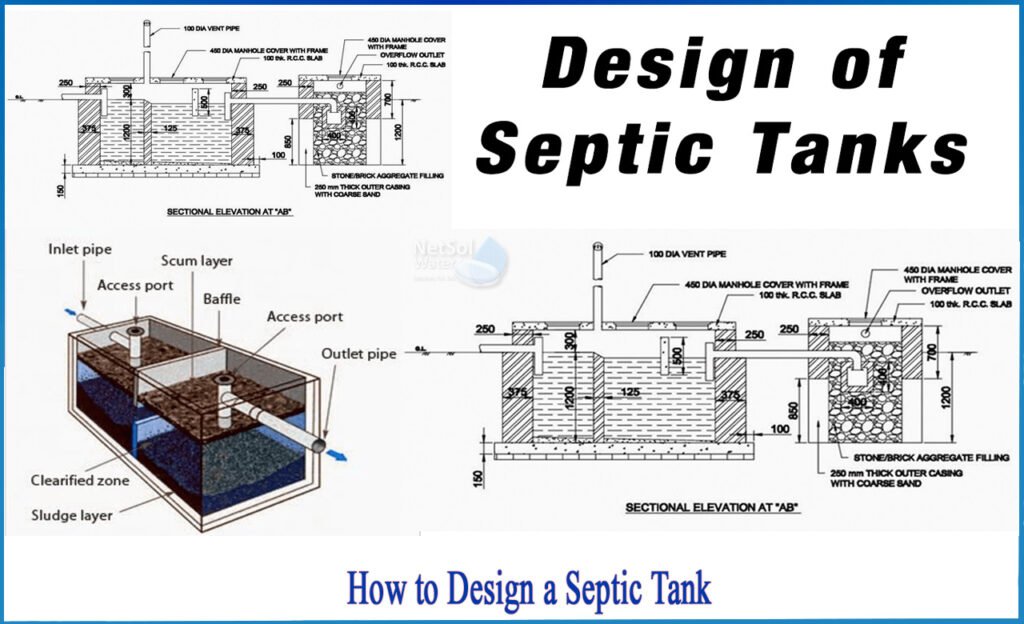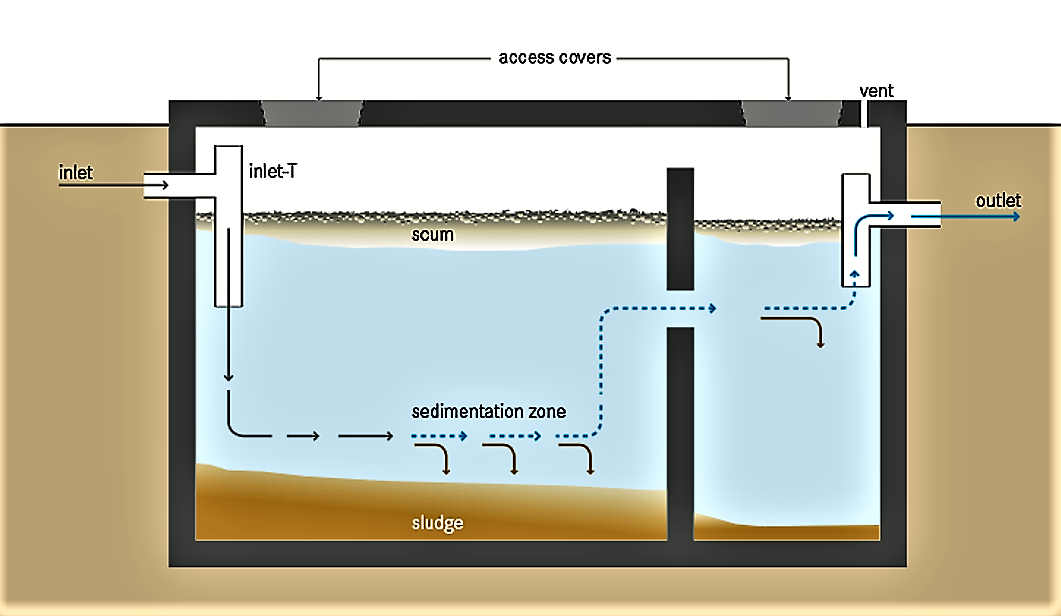A septic tank is a must-have sanitation system in areas without a centralized sewer network. In rural India and growing towns, many homes, schools, hostels, and small apartments rely on septic tanks for waste treatment. Designing the septic tank correctly is essential to ensure hygiene, safety, and long-term performance.
This detailed article explains how to design a septic tank in India, using simple English. It is based on the Indian Standard IS 2470 (Part 1) and includes practical examples, tables, and FAQs.
What Is a Septic Tank?

A septic tank is an underground, watertight chamber that holds household sewage for treatment. The tank works by separating solids from liquids. The heavier waste settles at the bottom as sludge. The lighter waste like oil and grease floats on top as scum. The remaining liquid in the middle flows out as effluent, usually into a soak pit or leach field.
This system allows anaerobic digestion (without oxygen) of the waste. This reduces harmful content in sewage and prevents groundwater pollution.
Importance of Proper Septic Tank Design in India
In many Indian regions, especially in Tier 2 and Tier 3 cities, lack of proper sanitation leads to pollution and health risks. A badly designed septic tank can overflow, smell, or contaminate drinking water.
Hence, following Indian standards for septic tank design ensures:
- Proper wastewater management
- Prevention of soil and groundwater pollution
- Reduced maintenance and costs
- Better hygiene and sanitation
Design Standards: IS 2470 (Part 1)
The Indian Standard Code IS 2470-1:1985 offers clear guidelines for designing septic tanks for up to 300 users. Below are its key design factors:
1. Sewage Flow Rate
- Domestic water usage: 135–225 litres/person/day
- Wastewater entering the tank: 40–70 litres/person/day
- With sludge: Total ~90–150 litres/person/day
2. Detention Time
- The wastewater should stay in the tank for at least 24 hours to allow proper settling.
- Time can range from 12 to 36 hours, depending on the number of users and tank volume.
3. Sludge Removal Frequency
- Tank should be desludged every 6–12 months.
- Sludge generation: ~30 litres/person/year
4. Septic Tank Dimensions
The size of the tank depends on:
- Number of users
- Sewage generation
- Type of building (residential, school, hostel, etc.)
Sample Septic Tank Design for a 5-Person Household
| Design Element | Calculation | Value |
|---|---|---|
| Daily sewage flow | 5 × 150 litres | 750 litres |
| Minimum tank volume | Add margin: round off to | 1000 litres (1 m³) |
| Tank shape ratio | Length:Width = 3:1 | 3 m × 1 m |
| Liquid depth | Minimum 1.0 m + 0.3 m freeboard | 1.3 m total depth |
| Sludge volume (1 yr) | 5 × 30 litres | 150 litres |
So, a Dimenson 3 m × 1 m × 1.3 m tank can safely serve a family of 5.
Septic Tank Dimensions for Multiple Users
| No. of Persons | Length (m) | Breadth (m) | Depth (m) | Sludge Clearance (months) |
|---|---|---|---|---|
| 5 | 1.5 | 0.75 | 1.0 | 12 |
| 10 | 2.0 | 0.75 | 1.0 | 12 |
| 15 | 2.0 | 0.90 | 1.0 | 12 |
| 20 | 2.3 | 1.10 | 1.0 | 12 |
| 50 | 4.0 | 1.20 | 1.3 | 6 |
| 100 | 5.7 | 1.30 | 1.3 | 6 |
For more than 20 users, multi-chamber tanks or tanks in parallel are recommended.
Also Read Basalt Rock Price & Uses in India: A Practical Guide for Builders, Engineers & Buyers
Materials for Septic Tank Construction
- RCC (Reinforced Cement Concrete) is the most durable.
- Brick masonry with plaster is cheaper but may leak if not waterproofed.
- Precast concrete and HDPE septic tanks are also used in modern housing projects.
Ensure that the inner surface is waterproof and resistant to corrosion and sewage gases.
Inlet and Outlet Design
- Inlet pipe should enter slightly below the scum level to avoid turbulence.
- Outlet pipe should draw liquid from the clear middle layer.
- Use T-pipes or baffles to separate sludge and scum effectively.
Effluent Disposal After Septic Tank
After treatment, the liquid (effluent) must be disposed of safely. Common disposal methods in India:
- Soak Pit – A circular or square pit filled with gravel to allow water to seep into the ground.
- Leach Field – A network of perforated pipes laid underground that distributes effluent.
- Constructed Wetlands – Useful for larger buildings like schools or hostels.
Before constructing a soak pit or leach field, always conduct a soil percolation test.
Best Practices for Septic Tank Installation
- Place tank at least 15 feet away from a borewell or drinking water source.
- Maintain a minimum slope in the inlet and outlet pipes.
- Install manholes or covers for cleaning and inspection.
- Avoid planting trees nearby to prevent root damage.
- Ensure the tank is ventilated to release harmful gases like methane.
Common Septic Tank Problems and Solutions
| Problem | Cause | Solution |
|---|---|---|
| Overflow or backup | Sludge not removed on time | Clean the tank every 6–12 months |
| Foul smell | Blocked ventilation | Check vent pipe and clear blockage |
| Groundwater pollution | Cracked or leaking tank walls | Waterproof tank with cement slurry |
| Effluent not absorbing | Soil percolation too low | Use leach field or constructed wetland |
| Mosquito breeding | Open or broken tank cover | Seal and fix covers properly |
Frequently Asked Questions (FAQs)
Q1. How often should a septic tank be cleaned?
It should be cleaned every 6 to 12 months, depending on usage and tank size.
Q2. What is the cost of building a septic tank in India?
Cost depends on material and size. For a small house (5 users), construction cost ranges between ₹15,000 to ₹40,000.
Q3. Can we build a septic tank under the house?
Avoid doing this. It makes maintenance difficult and can cause bad odour inside.
Q4. Can rainwater enter a septic tank?
No. Septic tanks should be covered and sealed. Stormwater should not mix with sewage.
Q5. Can we use chemical additives in the septic tank?
It is not recommended. Natural bacterial processes are enough if waste is biodegradable.
Conclusion
A well-designed septic tank is essential for safe sanitation, especially in Indian homes where municipal sewerage is not available. By following IS 2470 (Part 1) and using correct sizing, material, and disposal methods, you can build an efficient, long-lasting septic tank.
Remember to desludge regularly, maintain proper ventilation, and dispose of effluent safely. A poorly maintained septic tank can cause pollution, smell, and health hazards. Follow best practices and maintain hygiene around your home and community.










